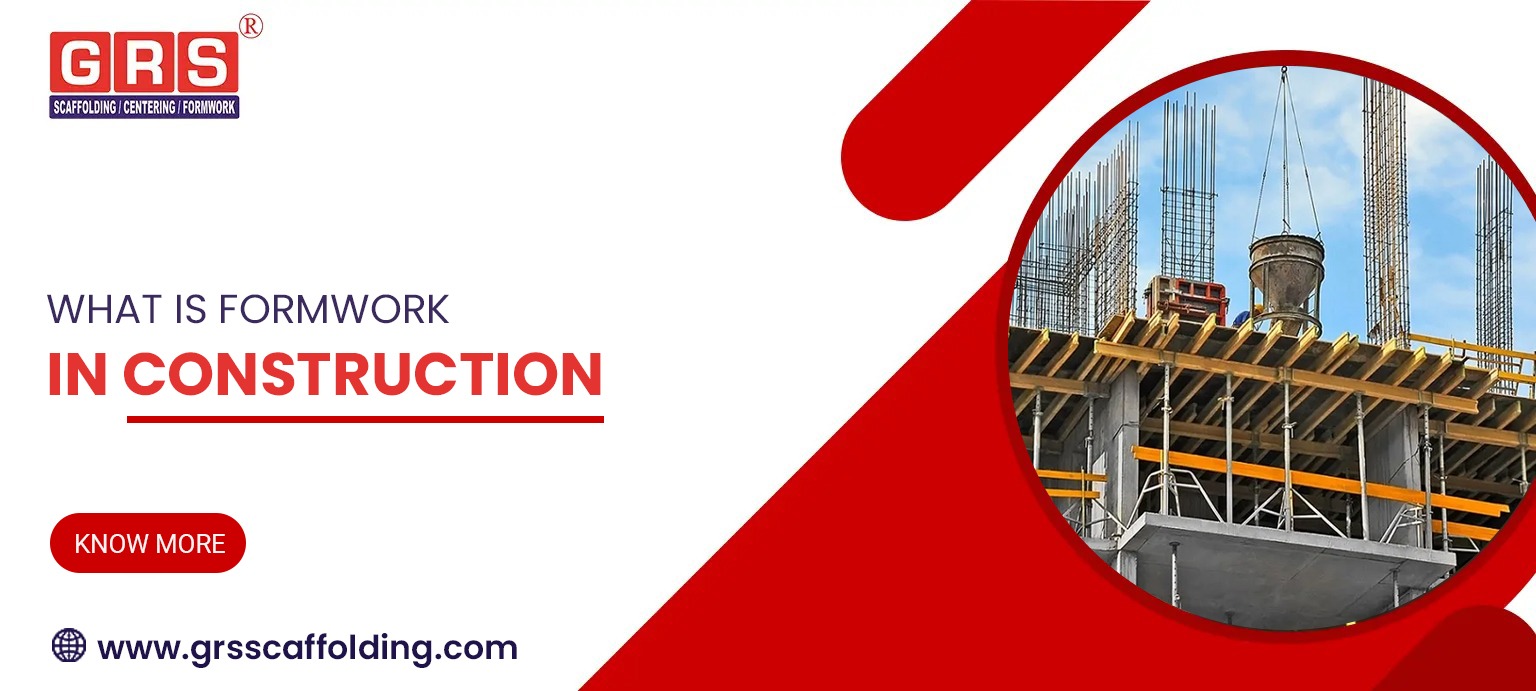Formwork is a crucial aspect of construction, playing a central role in shaping concrete structures. In this comprehensive guide, we delve into what formwork is, its various types, construction process, and the advantages it offers in the world of construction.
- Importance Of Formwork In Construction:
- Types Of Formwork:
- Construction Process Using Formwork
- 1. Project Planning and Design:
- 2. Material Procurement:
- 3. Site Preparation:
- 4. Formwork Assembly:
- 5.Reinforcement Installation:
- 6. Formwork Inspection:
- 7.Concrete Mixing and Pouring:
- 8. Concrete Compaction:
- 9. Curing and Setting:
- 10.Formwork Removal:
- 11. Finishing and Quality Control:
- 12. Additional Construction Steps:
- 13. Project Completion:
- Advantages Of Using Formwork
- Challenges And Considerations
- Conclusion:
Importance Of Formwork In Construction:
Formwork is a critical component in the construction industry, playing a pivotal role in the successful execution of various building and infrastructure projects.
Its importance cannot be overstated, as it serves several key functions that are essential for achieving structural integrity, safety, and efficiency in construction.
Here are some of the primary reasons why formwork is crucial in construction:
1. Structural Support:
Formwork provides temporary support to the freshly poured concrete until it gains sufficient strength to support its own weight and any additional loads. This is essential for preventing deformations, cracks, and failures in the concrete structure during the curing period.
2. Shape and Geometry:
Formwork allows for the creation of complex and customized shapes and structures in concrete construction. Whether it’s curved walls, unique architectural features, or intricate designs, formwork serves as a mold that ensures the concrete takes the desired shape and maintains its accuracy.
3. Quality Control:
Properly designed and installed formwork helps ensure that the concrete surface is smooth, even, and free from imperfections. This results in a higher-quality finish, which is crucial for aesthetic appeal in architectural projects and for ensuring the structural integrity of load-bearing elements.
4. Safety:
Formwork systems are designed with safety in mind. They provide a stable working platform for construction workers, reducing the risk of accidents and injuries. Additionally, they protect workers from falling debris and wet concrete.
5. Cost Efficiency:
Efficient formwork systems can significantly reduce construction time and labor costs. By speeding up the construction process, formwork minimizes downtime and allows for multiple phases of work to occur simultaneously, ultimately saving time and money.
Formwork is an indispensable element of construction, serving as the mold that shapes concrete structures, ensures their strength and durability, and contributes to safety and cost-effectiveness.
Its significance extends from foundational concrete slabs to complex architectural masterpieces, making it an essential aspect of modern construction practices.
Types Of Formwork:
Formwork in construction comes in various types, each tailored to specific project needs. Here’s a brief overview of some common types:
1. Timber Formwork:
Utilizing timber boards and plywood, this traditional formwork is cost-effective and flexible, making it suitable for simple structures.
2. Steel Formwork:
Made from steel sheets and frames, this robust formwork type is durable, easy to assemble, and ideal for repetitive use in large-scale projects.
3. Aluminum Formwork:
Lightweight yet sturdy, aluminum formwork is favored for its efficiency and adaptability, often employed in constructing high-rise buildings and residential complexes.
4. Plastic Formwork:
Reusable plastic panels or molds offer versatility and reduce labor requirements, particularly in projects where concrete needs to be poured in intricate shapes.
5. Engineered Formwork Systems:
These innovative systems, like modular or tunnel formwork, are designed for specific project demands, streamlining construction processes and ensuring precision.
6. Climbing Formwork:
Designed for vertical structures like skyscrapers, climbing formwork allows for continuous construction progress by moving upward as each section is completed.
7. Slipform Formwork:
Ideal for cylindrical structures such as silos and towers, slipform formwork continuously molds concrete, creating seamless, high-quality surfaces.
8. Tunnel Formwork:
Primarily used in underground construction, tunnel formwork facilitates the creation of tunnels and underground structures efficiently.
Each type of formwork serves distinct construction needs, offering advantages in terms of speed, cost-efficiency, and adaptability to various project requirements.
The choice of formwork depends on factors like project scale, complexity, and budget, with each type contributing to the successful realization of construction projects.
You definitely need Scaffolding Products,when you use Formwork on your construction project. We recommend you to check out our Scaffolding Patna page, where you can see how people use our Scaffolding Products on their projects and also you can know why they are so much satisfied with our Scaffolding products.
Construction Process Using Formwork
The construction process using formwork is a well-structured sequence of steps aimed at creating concrete structures with precision, strength, and safety.
Here’s an overview of the typical construction process using formwork:
1. Project Planning and Design:
The construction project begins with detailed planning and design, including architectural and structural plans. Formwork requirements are determined based on the design, specifying the type of formwork needed for each component of the structure.
2. Material Procurement:
Procure the necessary materials, which include formwork panels, supports, ties, braces, and release agents.Ensure that all materials meet quality and safety standards.
3. Site Preparation:
Prepare the construction site, ensuring it is level, stable, and properly drained.
Establish the layout and dimensions of the structure using reference points and surveying equipment.
4. Formwork Assembly:
Erect the formwork according to the design and layout specifications. This involves setting up the formwork panels, frames, and supports.Ensure that the formwork is level, plumb, and securely braced to withstand the pressure of the concrete.
5.Reinforcement Installation:
Place and secure steel reinforcement (rebar or mesh) within the formwork to provide additional strength to the concrete structure.Ensure that the reinforcement is positioned according to design requirements.
6. Formwork Inspection:
Conduct a thorough inspection of the formwork to verify its stability, alignment, and proper bracing.Check for any gaps, leaks, or defects that may compromise the integrity of the concrete.
7.Concrete Mixing and Pouring:
Prepare the concrete mix with the appropriate proportions of cement, aggregates, water, and additives.Pour the concrete into the formwork in a controlled manner, starting from one end and progressing systematically to avoid segregation.
8. Concrete Compaction:
Compact the concrete using vibrators to remove air voids and ensure proper consolidation.
Ensure that the concrete reaches all corners and edges of the formwork.
9. Curing and Setting:
Cover the freshly poured concrete with curing blankets or a curing compound to prevent rapid moisture loss.Allow the concrete to set and gain strength according to the specified curing period.
10.Formwork Removal:
Once the concrete has achieved the necessary strength, carefully remove the formwork panels, starting with the vertical supports.Take precautions to prevent damage to the concrete surface during formwork removal.
11. Finishing and Quality Control:
Perform finishing tasks, such as smoothing and texturing the concrete surface as needed.
Inspect the concrete for defects, cracks, or imperfections and address any issues promptly.
12. Additional Construction Steps:
Depending on the project, additional steps such as electrical and plumbing installations, interior finishing, and landscaping may follow the concrete work.
13. Project Completion:
Once all construction tasks are finished, conduct a final inspection to ensure that the structure meets design specifications and safety standards.Hand over the completed project to the client or project owner.
Throughout the construction process using formwork, safety measures, quality control, and adherence to design specifications are paramount. Effective project management and communication among the construction team members are also essential to ensure a successful and timely project delivery.
Advantages Of Using Formwork
Using formwork in construction offers numerous advantages that contribute to the efficiency, safety, and quality of concrete structures. Here are some key advantages:
1. Accurate Shape and Dimensions:
Formwork ensures that concrete elements are constructed with precision, adhering to the specified shape, size, and alignment outlined in architectural and engineering plans.
2. Structural Integrity:
Formwork provides essential support during the curing period, preventing deformation or failure of concrete elements, which is crucial for the long-term structural integrity of the building.
3. Customization:
Formwork allows for the creation of complex and customized designs, including curves, arches, and unique architectural features, making it suitable for a wide range of construction projects.
4. Speed and Efficiency:
Properly designed and installed formwork systems can expedite the construction process, reducing overall project duration and labor costs by allowing for faster concrete placement and curing.
5. Quality Finish:
Formwork contributes to a smooth and even concrete surface finish, essential for aesthetics in architectural projects and for functional purposes in structural elem
The use of formwork in construction is instrumental in achieving precise, safe, and efficient construction processes.
It enables the creation of high-quality concrete structures that meet design specifications and industry standards while offering various benefits, including cost savings and environmental sustainability.
Challenges And Considerations
Using formwork in construction offers many advantages, but it also presents several challenges and considerations that need to be carefully managed to ensure a successful project. Here are some key challenges and considerations related to formwork:
1. Design and Engineering:
Complexity:
Designing formwork for intricate architectural designs or irregular shapes can be challenging and may require specialized engineering expertise.
Structural Integrity:
Ensuring that the formwork can withstand the weight and pressure of wet concrete without deforming or failing is crucial for safety and quality.
2. Material Selection:
Compatibility:
Choosing the right formwork material that is compatible with the type of concrete mix and curing methods is essential to prevent issues like staining or surface defects.
Cost
High-quality formwork materials can be expensive, and balancing cost considerations with performance requirements is critical.
3. Construction Site Factors:
Space Constraints:
Limited space on the construction site can pose challenges in terms of setting up and dismantling formwork.
Accessibility:
Ensuring that the formwork is accessible for concrete placement and finishing can be a logistical challenge, especially in confined or elevated spaces.
4. Safety:
Worker Safety:
Formwork installation, concrete pouring, and formwork removal can be hazardous tasks, and safety measures must be rigorously enforced to protect workers from accidents and falls.
Concrete Pressure:
Managing the pressure exerted by wet concrete on the formwork to prevent blowouts or collapses is essential for safety.
5. Quality Control:
Alignment and Dimensions:
Maintaining precise alignment and dimensions of the formwork is critical to achieving the desired shape and size of the concrete elements.
Concrete Placement:
Ensuring proper concrete placement, compaction, and curing are essential for the quality of the final structure.
Managing these challenges and considerations requires thorough planning, skilled labor, effective project management, and a commitment to safety and quality.
Successful formwork implementation plays a pivotal role in achieving the desired results in construction projects, whether they are residential, commercial, or infrastructure-related.
Conclusion:
In conclusion, formwork is the silent hero behind the concrete marvels that define our world. From traditional timber to cutting-edge innovations, it’s the backbone of precision and efficiency in construction. Embracing formwork’s advantages and addressing its challenges paves the way for a brighter, more sustainable future in the construction industry.
Feel free to reach out to GRS Scaffolding right away if you need further assistance or if you’re interested in acquiring our Formwork. We’re here to assist you with enthusiasm and expertise.

